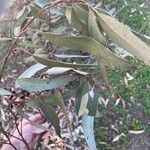A slender tree. It grows 25-50 m tall and spreads 25 m wide. The bark is powdery and grey and peels off. The leaves are broadly sword shaped and rough and green. The young leaves are more broad. The leaves have a lemon scent. The flowers are in clusters and are creamy white. They are 2 cm across.
Tall tree. Bark smooth and deciduous throughout. This species is very closely related to E. maculata Hook, and is sometimes treated as a variety of it.


